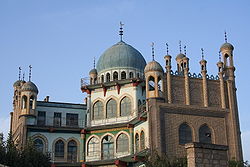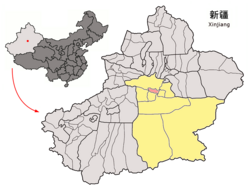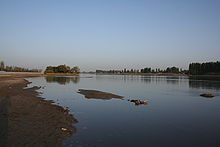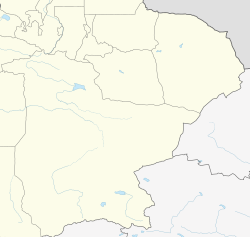Yanqi Hui Autonomous County
Yanqi Hui Autonomous County
Kara Shahr, Yenki, Qarasheher, Karashahr | |
|---|---|
 Mosque in the city center of Yanqi | |
 Yanqi County (red) within Bayin'gholin Prefecture (yellow) and Xinjiang | |
| Coordinates: 42°03′35″N 86°34′27″E / 42.0598°N 86.5741°E | |
| Country | China |
| Autonomous region | Xinjiang |
| Autonomous prefecture | Bayin'gholin |
| County seat | Karasahr (Yanqi) |
| Area | |
| • Total | 2,429.2 km2 (937.9 sq mi) |
| Population (2020)[1] | |
| • Total | 122,961 |
| • Density | 51/km2 (130/sq mi) |
| Time zone | UTC+8 (China Standard[a]) |
| Website | www |
| Yanqi Hui Autonomous County | |||||||||||
|---|---|---|---|---|---|---|---|---|---|---|---|
 | |||||||||||
| Chinese name | |||||||||||
| Simplified Chinese | 焉耆回族自治县 | ||||||||||
| Traditional Chinese | 焉耆回族自治縣 | ||||||||||
| |||||||||||
| Uyghur name | |||||||||||
| Uyghur | يەنجى خۇيزۇ ئاپتونوم ناھىيىسى | ||||||||||
| |||||||||||
Yanqi Hui Autonomous County (Uyghur: Qarasheher, Karashahr) is an autonomous county in the Xinjiang Uyghur Autonomous Region and is under the administration of the Bayin'gholin Mongol Autonomous Prefecture. It has an area of 2,429 km2 (938 sq mi). According to the 2002 census, it has a population of 120,000. The Shikshin Buddhist Temple Ruins are located in Yanqi County, about 25–30 km (16–19 mi) southwest of the town of Yanqi.
Administrative division[edit]
The Yanqi Hui Autonomous County is made up of 4 towns and 4 townships:[2]
| Name | Simplified Chinese | Hanyu Pinyin | Uyghur (UEY) | Uyghur Latin (ULY) | Mongolian (traditional) | Mongolian (Cyrillic) | Administrative division code | |
|---|---|---|---|---|---|---|---|---|
| Towns | ||||||||
| Karasahr Town (Yanqi Town) |
焉耆镇 | Yānqí Zhèn | قاراشەھەر بازىرى | qarasheher baziri | ᠶᠠᠨᠵᠢ ᠪᠠᠯᠭᠠᠰᠤ | Яанж балгас | 652826100 | |
| Xigxin Town (Shikshin Town, Qigxin Town) |
七个星镇 | Qīgèxīng Zhèn | شىگشىن بازىرى | shigshin baziri | 652826101 | |||
| Yongning Town | 永宁镇 | Yǒngníng Zhèn | يۇڭنىڭ بازىرى | yungning baziri | 652826102 | |||
| Denzil Town (Sishilichengzi Town) |
四十里城子镇 | Sìshílǐchéngzǐ Zhèn | دەنزىل بازىرى | denzil baziri | 652826103 | |||
| Townships | ||||||||
| Beidaqu Township | 北大渠乡 | Běidàqú Xiāng | بېيداچۈ يېزىسى | bëydachü yëzisi | 652826200 | |||
| Wuhaoqu Township | 五号渠乡 | Wǔhàoqú Xiāng | ۋۇخاۋچۈ يېزىسى | wuxawchü yëzisi | 652826201 | |||
| Qagan Qehe Township | 查汗采开乡 | Cháhàncǎikāi Xiāng | چاغانچېكە يېزىسى | chaghanchëke yëzisi | 652826203 | |||
| Borhoi Township | 包尔海乡 | Bāo'ěrhǎi Xiāng | بورقاي يېزىسى | borqay yëzisi | 652826204 | |||
Others:
- Wangjiazhuang Pasture (王家庄牧场, ۋاڭجياجۇاڭ چارۋىچىلىق فېرمىسى)
- Suhai Seed Farm (苏海良种场)
Demographics[edit]
History[edit]
See Karasahr.
Climate[edit]
| Climate data for Yanqi (1991–2020 normals, extremes 1981–2010) | |||||||||||||
|---|---|---|---|---|---|---|---|---|---|---|---|---|---|
| Month | Jan | Feb | Mar | Apr | May | Jun | Jul | Aug | Sep | Oct | Nov | Dec | Year |
| Record high °C (°F) | 6.8 (44.2) |
12.6 (54.7) |
24.1 (75.4) |
33.6 (92.5) |
34.9 (94.8) |
36.1 (97.0) |
38.8 (101.8) |
38.8 (101.8) |
34.6 (94.3) |
28.3 (82.9) |
18.5 (65.3) |
7.4 (45.3) |
38.8 (101.8) |
| Mean daily maximum °C (°F) | −4.3 (24.3) |
3.4 (38.1) |
12.9 (55.2) |
21.4 (70.5) |
26.3 (79.3) |
29.6 (85.3) |
31.1 (88.0) |
30.3 (86.5) |
25.8 (78.4) |
18.1 (64.6) |
7.8 (46.0) |
−2.1 (28.2) |
16.7 (62.0) |
| Daily mean °C (°F) | −11.1 (12.0) |
−4.3 (24.3) |
4.9 (40.8) |
13.4 (56.1) |
18.7 (65.7) |
22.4 (72.3) |
23.6 (74.5) |
22.3 (72.1) |
17.3 (63.1) |
9.4 (48.9) |
0.8 (33.4) |
−7.4 (18.7) |
9.2 (48.5) |
| Mean daily minimum °C (°F) | −16.4 (2.5) |
−11.0 (12.2) |
−2.5 (27.5) |
5.5 (41.9) |
11.1 (52.0) |
15.2 (59.4) |
16.6 (61.9) |
15.2 (59.4) |
9.7 (49.5) |
2.4 (36.3) |
−4.4 (24.1) |
−11.7 (10.9) |
2.5 (36.5) |
| Record low °C (°F) | −26.8 (−16.2) |
−24.9 (−12.8) |
−16.4 (2.5) |
−4.4 (24.1) |
−0.9 (30.4) |
4.7 (40.5) |
7.2 (45.0) |
6.0 (42.8) |
0.1 (32.2) |
−6.4 (20.5) |
−21.6 (−6.9) |
−25.9 (−14.6) |
−26.8 (−16.2) |
| Average precipitation mm (inches) | 1.6 (0.06) |
2.3 (0.09) |
1.9 (0.07) |
5.4 (0.21) |
12.1 (0.48) |
14.3 (0.56) |
16.6 (0.65) |
13.4 (0.53) |
6.5 (0.26) |
4.0 (0.16) |
1.2 (0.05) |
1.8 (0.07) |
81.1 (3.19) |
| Average precipitation days (≥ 0.1 mm) | 2.9 | 1.5 | 0.7 | 1.2 | 2.6 | 4.7 | 6.8 | 4.5 | 2.8 | 1.4 | 0.7 | 2.9 | 32.7 |
| Average snowy days | 8.9 | 2.6 | 0.4 | 0.5 | 0 | 0 | 0 | 0 | 0 | 0.2 | 0.9 | 8.5 | 22 |
| Average relative humidity (%) | 76 | 63 | 47 | 40 | 42 | 49 | 55 | 56 | 57 | 61 | 70 | 77 | 58 |
| Mean monthly sunshine hours | 161.7 | 194.8 | 250.9 | 270.7 | 307.4 | 293.8 | 299.3 | 295.5 | 286.2 | 264.3 | 202.4 | 130.4 | 2,957.4 |
| Percent possible sunshine | 54 | 64 | 67 | 67 | 68 | 65 | 66 | 70 | 78 | 79 | 70 | 46 | 66 |
| Source: China Meteorological Administration[4][5] | |||||||||||||
Economy[edit]
The county economy is predominantly agricultural with 13,000 hectares used to cultivate red pepper.[6] The county is considered the most important area for red pepper production in China.[6] During the red pepper harvest season beginning in September, the county is home to the remarkable sight of drying peppers sitting in the Gobi Desert "as far as the eye can see".[6]
As of 1885[update], there was about 25,300 acres (167,805 mu) of cultivated land in Kara Shahr.[7]
Notes[edit]
- ^ Locals in Xinjiang frequently observe UTC+6 (Xinjiang Time), 2 hours behind Beijing.
References[edit]
- ^ Xinjiang: Prefectures, Cities, Districts and Counties
- ^ 2022年统计用区划代码和城乡划分代码:焉耆回族自治县. National Bureau of Statistics of China.
- ^ 3-7 各地、州、市、县(市)分民族人口数 [3-7 Population by Nationality by Prefecture, State, City and County (City)]. tjj.xinjiang.gov.cn (in Chinese). Statistical Bureau of Xinjiang Uyghur Autonomous Region. 2020-06-10. Archived from the original on 2020-11-01. Retrieved 2021-06-11.
- ^ 中国气象数据网 – WeatherBk Data (in Simplified Chinese). China Meteorological Administration. Retrieved 10 October 2023.
- ^ 中国气象数据网 (in Simplified Chinese). China Meteorological Administration. Retrieved 10 October 2023.
- ^ a b c "Yanqi Hui county starts 13000 hectare red pepper bumper harvest". China News Xinjiang. September 19, 2017.
- ^ Herold J. Wiens (November 1966). "Cultivation Development and Expansion in China's Colonial Realm in Central Asia". The Journal of Asian Studies. 26 (1): 75. doi:10.2307/2051832. JSTOR 2051832. S2CID 162339064.



